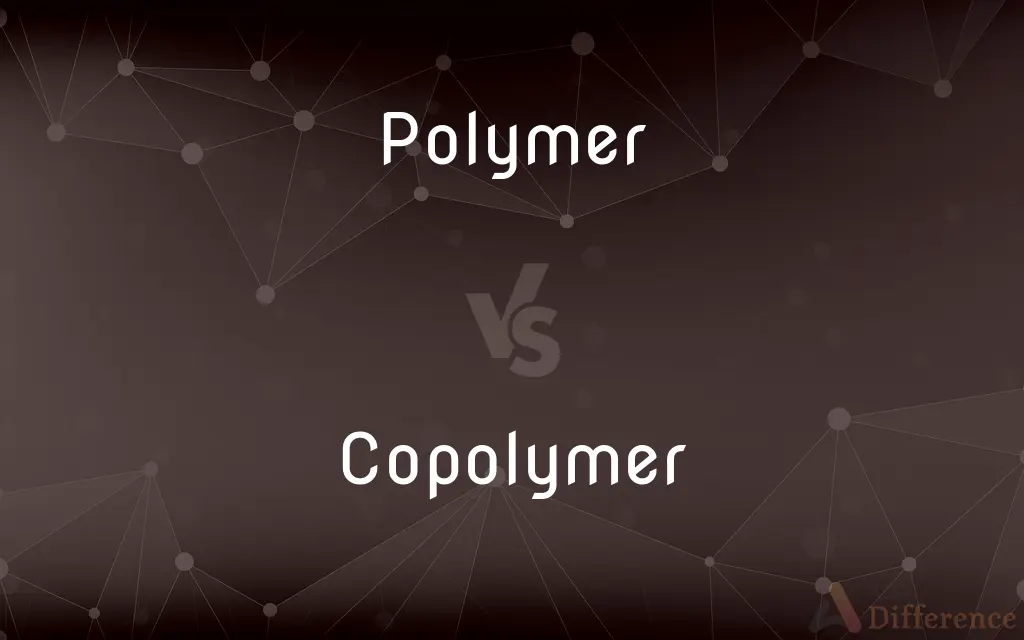Polymer vs. Copolymer — What's the Difference?
By Tayyaba Rehman — Updated on September 28, 2023
Polymer is a large molecule composed of repeating subunits; Copolymer is formed from two different types of monomers.

Difference Between Polymer and Copolymer
Table of Contents
ADVERTISEMENT
Key Differences
Polymer and Copolymer are significant terms in materials science, referring to different kinds of macromolecules. A polymer is a large molecule composed of repeating structural units or monomers. Polymers exhibit extensive variability and versatility, allowing them to be tailored for specific needs. Polyethylene, a common polymer, is widely used in packaging due to its durability and flexibility.
A copolymer, on the other hand, is a type of polymer that is synthesized from two different types of monomers. The inclusion of different monomers allows for the development of copolymers with specific attributes and characteristics that may not be achievable with single-monomer polymers. Copolymers, like Styrene-Butadiene Rubber (SBR), combine the properties of their constituent monomers, offering enhanced performance and application scope.
Understanding the distinctions between polymers and copolymers is crucial in the synthesis of materials with desired properties and applications. Polymers are characterized by the repetition of a single type of monomer, allowing for uniform properties along the chain. Copolymers introduce diversity in the chain through the incorporation of different monomers, permitting the fine-tuning of the resultant material’s characteristics.
In practical applications, the choice between using a polymer or a copolymer depends on the required properties of the material. Polymers, with their uniform structure, offer consistency and reliability in performance. Copolymers, with the integration of diverse monomers, can be designed to meet specific needs, displaying properties that are a blend of the contributing monomers.
Polymer and Copolymer synthesis is fundamental in developing new materials for various industries such as automotive, medical, and consumer goods. These macromolecules play a pivotal role in innovation, enabling the development of materials with unparalleled characteristics and functionalities, catering to evolving industrial and consumer demands.
ADVERTISEMENT
Comparison Chart
Definition
Large molecule of repeating units.
Formed from two different monomers.
Composition
Single type of monomer.
At least two different types of monomers
Example
Polyethylene is a common polymer.
Styrene-Butadiene Rubber is a copolymer.
Properties
Uniform and consistent.
Varied and customizable.
Application
Extensive, in various industries.
Specific, tailored for unique needs.
Compare with Definitions
Polymer
A substance created through polymerization, where monomers are covalently bonded.
The creation of synthetic fibers involves the use of polymers like nylon.
Copolymer
A polymer formed from more than one type of monomer unit.
Styrene-Butadiene Rubber, a copolymer, is used in making car tires due to its combined properties of resilience and abrasion resistance.
Polymer
Macromolecule with high molecular mass, formed by repetitive linking of small molecules.
Polymers are essential in the textile industry for making synthetic fabrics like polyester.
Copolymer
A complex molecule made by polymerizing multiple types of monomers.
Copolymers are widely used in various applications such as in the production of high-performance plastics.
Polymer
A large, typically chain-like molecule composed of many identical or similar monomeric units.
Polyethylene, a widely-used polymer, is found in many plastic products.
Copolymer
A polymer chain consisting of at least two different types of repeating units.
The properties of copolymers like SBR can be adjusted by varying the ratio of the constituent monomers.
Polymer
A material composed of large molecules, exhibiting unique properties based on its structure.
Many medical devices utilize polymers due to their versatility and adaptability.
Copolymer
A macromolecule synthesized from two different monomeric species.
Copolymers are often created to combine the desirable features of two different polymers.
Polymer
A chemical compound with molecules bonded together in long, repeating chains.
Polymers such as rubber are crucial for the production of tires.
Copolymer
A chemical compound with varied composition, formed by polymerizing different monomers.
The versatility of copolymers allows for the development of materials with a broad range of properties and applications.
Polymer
A polymer (; Greek poly-, "many" + -mer, "part") is a substance or material consisting of very large molecules, or macromolecules, composed of many repeating subunits. Due to their broad spectrum of properties, both synthetic and natural polymers play essential and ubiquitous roles in everyday life.
Copolymer
A copolymer is a polymer derived from more than one species of monomer. The polymerization of monomers into copolymers is called copolymerization.
Polymer
Any of numerous natural and synthetic compounds of usually high molecular weight consisting of up to millions of repeated linked units, each a relatively light and simple molecule.
Copolymer
A polymer of two or more different monomers.
Polymer
(organic chemistry) A long or larger molecule consisting of a chain or network of many repeating units, formed by chemically bonding together many identical or similar small molecules called monomers. A polymer is formed by polymerization, the joining of many monomer molecules.
Copolymer
(chemistry) A polymer derived from more than one species of monomer.
Polymer
A material consisting of such polymer molecules.
Copolymer
A polymer consisting of two or more different monomers
Polymer
Any one of two or more substances related to each other by polymerism; specifically, a substance produced from another substance by chemical polymerization.
Polymer
A naturally occurring or synthetic compound consisting of large molecules made up of a linked series of repeated simple monomers
Share Your Discovery

Previous Comparison
Interactive vs. Interaction
Next Comparison
Blasphemy vs. HeresyAuthor Spotlight
Written by
Tayyaba RehmanTayyaba Rehman is a distinguished writer, currently serving as a primary contributor to askdifference.com. As a researcher in semantics and etymology, Tayyaba's passion for the complexity of languages and their distinctions has found a perfect home on the platform. Tayyaba delves into the intricacies of language, distinguishing between commonly confused words and phrases, thereby providing clarity for readers worldwide.
















































